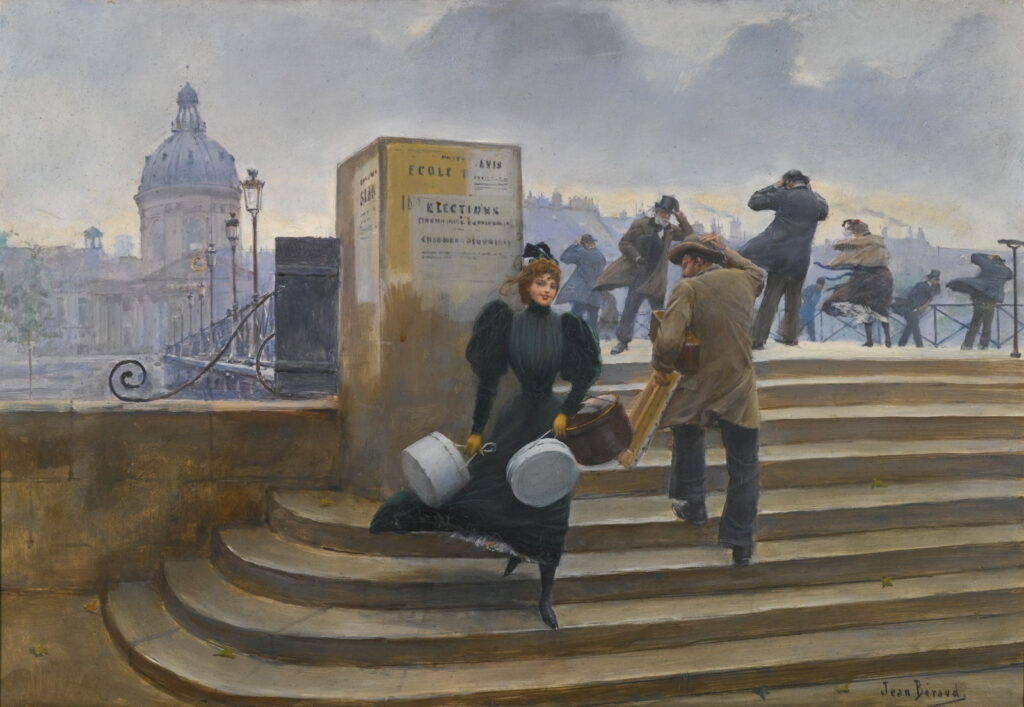Reading visual art: 119 The box, others

In addition to paintings of Pandora’s box, as shown in yesterday’s article, boxes are not uncommon accessories in paintings that are far from being mythological. Although most are cuboids with corners, some have distinctive form, such as those used to protect hats, which are most commonly round, giving rise to the hatbox that has become the trademark of hatters and milliners.
Charles Robert Leslie (1794–1859), Catherine and Petruchio (from William Shakespeare’s ‘The Taming of the Shrew’, Act iv, Sc.i) (1832), oil on canvas, 48.5 x 69 cm, National Trust, England. Wikimedia Commons.
Hatboxes have a long history, as shown in Charles Robert Leslie’s scene of Catherine and Petruchio (1832) from William Shakespeare’s play The Taming of the Shrew. Catherine is seated at the left, as her new husband dismisses the haberdasher and tailor bringing her new clothes, including an enormous green hat box held by an anxious tradesman.
Jean Béraud (1849–1935), The Milliner on the Champs Elysées (year not known), oil on canvas, 45.1 × 34.9 cm, Private collection. Wikimedia Commons.
Jean Béraud shows more recent examples in his undated Milliner on the Champs Elysées, who strolls smiling alongside the elegant carriages, two large hatboxes strung on her right forearm.
Anders Zorn (1860–1920), Omnibus (1891-92), oil on canvas, 99.5 x 66 cm, Nationalmuseum, Stockholm, Sweden. Wikimedia Commons.
Anders Zorn’s major project for the winter of 1891-92 was a painting that appears deceptively spontaneous, Omnibus. It takes advantage of a relatively novel and increasingly popular feature of public transport in cities like Paris. In its confines he crams five figures, including himself (wearing the top hat, second from right). The pretty young woman in the middle of the canvas is a milliner’s shop-girl, whose hand rests on a large hatbox, on this occasion cuboid rather than round.
William Hogarth (1697–1764), A Harlot’s Progress: 3 Apprehended by a Magistrate (engraving 1732 after painting c 1731), engraving, 31 x 38 cm, British Museum, London. Wikimedia Commons.
In the previous century, boxes were also used to carry and store wigs. In William Hogarth’s third painting in A Harlot’s Progress, Apprehended by a Magistrate (c 1731), he documents Moll’s descent into prostitution. Her bed is the only substantial piece of furniture in the room, her maid floridly syphilitic, with black pox marks on her face and a sunken bridge to her nose. She keeps a cat, who poses in the manner of her mistress at work. She’s surrounded by symbols of her evil, including a black witches hat and broomstick, and above the bed is a wig-box belonging to a highwayman who was hanged on 11 May 1730, and must have left his wig with her for safe keeping.
Jean-Léon Gérôme (1824–1904), Sculpturae Vitam Insufflat Pictura (Painting Breathes Life into Sculpture) (1893), oil on canvas, 50.2 x 69.2 cm, Art Gallery of Ontario, Toronto. Wikimedia Commons.
Boxes are the sort of detail that populate Jean-Léon Gérôme’s paintings. In 1874, archaeologists discovered large numbers of polychromed cast terracotta figurines in the Boeotian town of Tanagra. These dated from Greek civilisations active there during the late fourth century BCE, and their quantity and quality impressed many, including Gérôme. He moved on from his paintings of Pygmalion to two works in which he built imaginary worlds around Tanagra figurines. Sculpturae Vitam Insufflat Pictura (Painting Breathes Life into Sculpture) (1893) combines his own love of polychrome sculpture with a celebration of those archaeological discoveries. In doing so, Gérôme progresses his theme of visual revelation and truth, with these painted miniature humans, mimicking reality, and a wooden box of masks in the foreground.
Arthur Rackham (1867–1939), Illustration for Edition of ‘A Christmas Carol’ (1915), pen, ink and watercolour, further details not known. Images from the British Library and others, via Wikimedia Commons.
Cashboxes are more unusual in paintings, but make a guest appearance in those of Charles Dickens’ novella A Christmas Carol. This illustration by Arthur Rackham shows its hero Scrooge being visited by the ghost of his former business partner Marley, who wanders the earth shackled by chains and cashboxes after his lifetime of greed.
Jean Béraud (1849–1935), Milliner on the Pont des Arts (1879-82), oil on panel, 37.5 × 56 cm, Private collection. Wikimedia Commons.
Walking past another of Jean Béraud’s pretty young milliners here clutching no less than three hatboxes, in his Milliner on the Pont des Arts from 1879-82, is an artist carrying a canvas and paint box. He could be a self-portrait, or perhaps the character Elixir from Proust’s popular Remembrance of Things Past, who was a composite of Whistler, Vuillard, Helleu, Béraud himself, and others.
Carl Reichert (1836–1918), Der Malerstreit (The Painters’ Dispute) (1903), oil on panel, 24 x 30 cm, Private collection. Wikimedia Commons.
By the end of the nineteenth century, wooden ‘pochade’ boxes used by painters who worked en plein air could contain a dozen modern tubes of oil paint, as Carl Reichert shows in his witty Der Malerstreit (The Painters’ Dispute) (1903).
Joaquín Sorolla y Bastida (1863–1923), Maria Painting in El Pardo (1907), oil on canvas, 82 x 106 cm, Private collection. WikiArt.
Those working in front of the motif, such as Joaquín Sorolla’s daughter Maria Painting in El Pardo in 1907, could now work with a pochade box, under the shade of a large parasol.




